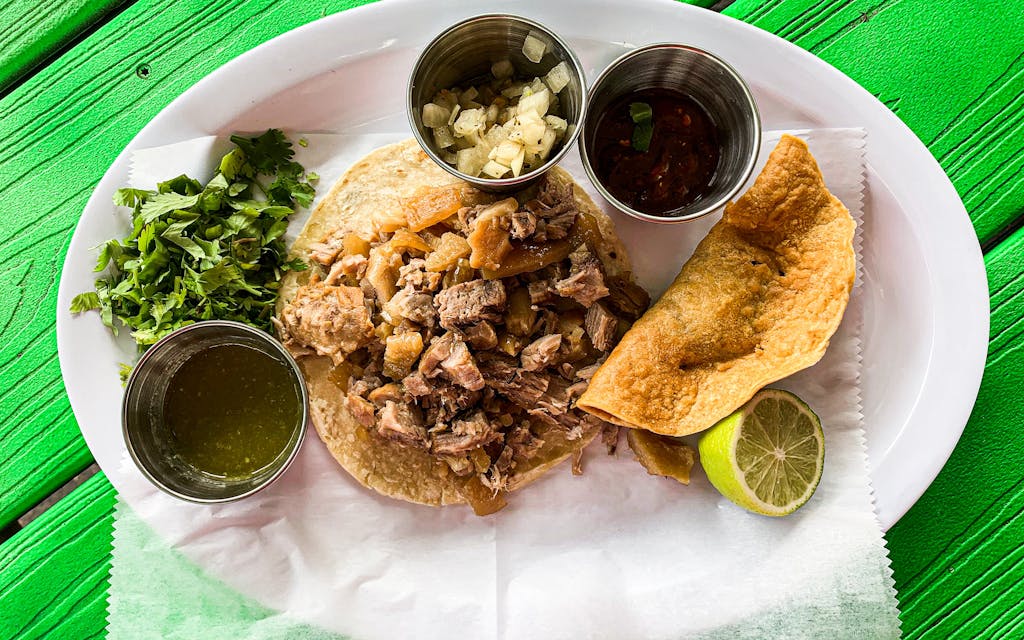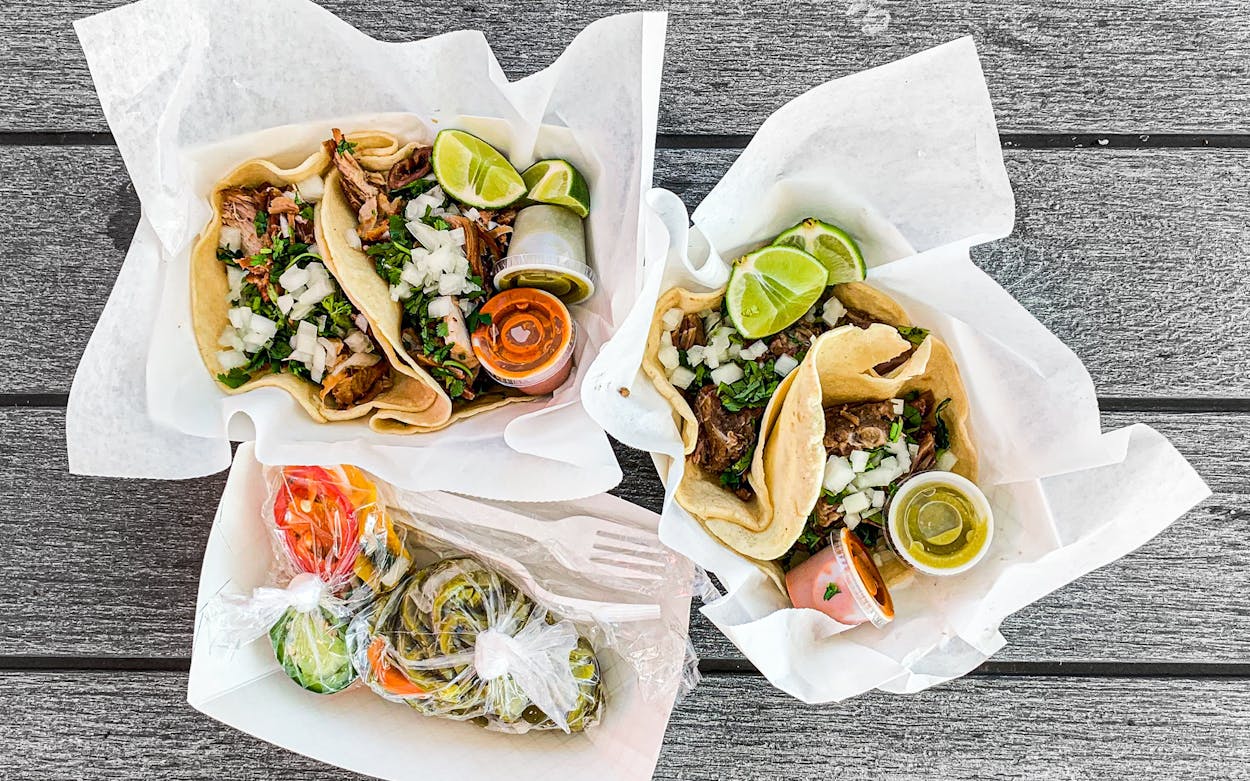For the last three years or so, the hottest trend in the taco world has been birria de res, a Jalisco, Mexico, import that traveled to the Lone Star State by way of California. Hundreds, if not thousands, of restaurants and trucks now offer a vast array of iterations of the consommé-dipped preparation, which has even made it into ramen and wontons. I’ve followed the birria boom since its inception, and now I’m seeing (and tasting) evidence that another taco revolution is starting to simmer across the state. It’s a dish you’ve likely heard of, one that has been served in Texas for more than a century. You may not have had the real thing, though, since preparing it right requires serious skill, knowledge, and time. I’m talking, of course, about carnitas.
Carnitas have been on Texas menus since at least 1915, when the dish was mentioned in San Antonio’s Spanish-language newspaper La Prensa. The filling’s preparation is deceptively simple, a collection of pig parts—ribs, leg, shoulder, and more—fried in lard (manteca) over several hours in a big copper pot, or cazo, until the meat glistens. Technically, it doesn’t even need to be pork, as carnitas translates to “little meats.” The manteca is often augmented with Coke, watered-down milk, herbs, and fruits, with each vendor fine-tuning his or her own secret sauce. This process is very similar to confit, the French technique in which food is cooked in its own fat. When the cooking is completed, the carnitas are moved to a chopping block and cleaved into threads both thick and thin. Carnitas hails from the Mexican state of Michoacán, and the pig dish is now found as an example of the pork-beef-chicken taco category at most taquerias. But a lot of chefs and diners take it for granted. At most taco joints, it’s almost certainly not confited in a cazo. Health regulations make cooking carnitas in the classic manner difficult. As a result, what most joints offer is oven-roasted pork shoulder, which lacks the rich depth and perky sweetness of flavor. There have always been excellent carnitas chefs (a.k.a. carniteros) in Texas, but they’ve toiled in near obscurity until recently. Now diners are starting to take notice—especially in San Antonio, which seems to be the epicenter of the trend.
Case in point: Carnitas Lonja and Carnitas Don Raúl-USA, which opened in 2017 and 2019, respectively. The latter has had to double the size of the cazo inside its truck to keep up with demand, while the former often sells out around lunch, if not earlier. I heard similar stories from chefs across the Alamo City—and as far afield as Odessa, where taco truck Carnitas El Peque regularly sells out in three hours.
Carnitas Lonja owner Alejandro Paredes sees similarities between the birria de res and carnitas movements—and he’s skeptical. “Some people right now are opening carnitas places just because they’re seeing them more and more on Instagram,” he says, without taking the time to do the research and hone their skills. These opportunists lack the patience that the dish requires.


Martin Muñoz, co-owner of Carnitas Don Raúl-USA, also believes we’re seeing a trend. “The more people are selling carnitas, the more people are talking about it. The word-of-mouth advertising is good for everyone,” he says. Soon enough, he believes, carnitas vendors will be setting up trailers and mobile stands: “They’re going to start doing it just like in Mexico,” where the tantalizing scent of carnitas is ubiquitous on many street corners and markets.
On San Antonio’s deep West Side, Casa Tarasca Carnitas Estilo Michoácan moved into a modern food truck this month after having served carnitas from a rickety trailer since April 2017. Owner José Luis Chavez and staff prepare carnitas off-site before moving them to the trailer. The building behind the truck is undergoing renovations to house Tarasca as a restaurant. The business is a passion project for Chavez, who has been a barber for twenty years. He owns the Acapulco barbershop adjacent to Casa Tarasca.
If you’re looking for excellent carnitas in Austin, try Carnitas El Güero, which began in 2017 as a gas-station cash-only counter. Owner Gustavo Reyes has always had big ambitions. “I couldn’t find a single good taco, so I decided to serve the very best taco,” he says. In 2018, he opened a sit-down location on North Lamar, North Austin’s taco mecca. In mid-September, the 35-year-old taquero expanded to San Antonio. In the first week the San Antonio outpost was open, he says, it made twice as much in sales as both Austin locations do in a month. Reyes is already planning a fourth location in Houston and looking ahead to franchising, maybe nationwide.


Although San Antonio has made a name for itself in the carnitas realm, the Houston area is a strong contender too. My favorite is Diego’s Famous Carnitas, a fire-truck-red trailer along a sparsely developed section of Veterans Memorial Drive, just inside Beltway 8. For the last four years, the Farias family has chopped up luscious pork for sale by the pound or as tacos and tortas. Owner Diego Farias, 58, moved from Quiroga, Mexico, one of three carnitas capitals—the others being Uruapan and Morelia—in Michoacán state in 1986. He and his wife, Sara, saved enough money to not have to take out loans and opened their trailer in April 2018. Daughter Daisy Farias was studying hotel and restaurant management at the University of Houston when she got roped in to helping at the trailer. She juggles slinging tacos with a second full-time job as a front desk manager at a hotel in Spring. Daisy has no regrets about joining the family business, though. “It’s fun,” she says. “I feel like it’s brought us closer and brought out the best in each of us.”
Her younger brother, Felipe Farias, was in high school when his family opened the carnitas trailer. His parents put him to work at 4 a.m. on weekends, when he’d wake up in pitch darkness to butcher as many as three pigs on Friday and now eight pigs on Saturday and Sunday. He also prepares the manteca and cazo. Now in his twenties, he doesn’t wake up as early—he too has a second job—but he is all in on the future of Diego’s Famous Carnitas, saying he’s excited to inherit the business, whenever his father is ready to retire, and to take Diego’s beyond the truck.
He’ll be the fourth carnitero in his family. He takes the craft seriously, and wants to take the Farias family’s operation to the next level. Felipe envisions a future that includes a brick-and-mortar restaurant and expanded output. He also knows what is at stake and what makes carnitas special. “Live by the pig, die by the pig,” he says with the youthful vigor of a man who is proud of his craft and knows it’s the life he wants to live. He learned that from his father, who told me much the same thing. “It’s part of me, my life, my well-being,” says Diego Farias. “I take an immense amount of pride in it.” Does he think carnitas are on the rise? “Yes, because when it’s something made with dedication and attention, it’s something that will last forever.”

The North Texas carnitas scene is growing too. Along a country road in the Fort Worth suburb of Mansfield, Israel Aguilar and his wife, Elena Nava, began serving carnitas in an empty lot fourteen years ago as Carnitas y Barbacoa El Güero. Their only equipment: a canopy, a flattop griddle, and a cazo. Three years ago, they moved into a large building on the property. It’s got space for two large dining rooms, long lines that spill out the door on weekends, and a two-section open kitchen. The exposed workspace allows customers to watch cooks cutting onions, making tortillas, and chopping carnitas. “I want you to see what you’re going to eat,” says Aguilar. A native of Querétaro state, he started learning the carnitas trade at age six to help his family pay the bills.
Sometimes chefs are ready for trends before diners are. Also in Dallas, Revolver Taco Lounge owner Regino Rojas, who hails from Michoacán, tried selling a carnitas-style octopus taco for nine years before it finally took hold. “I tried pushing that taco and pushing and pushing,” he says, raising his arms and waving his hands. “Then, one day, pow, it was a hit.” The taco has a briny flavor midway through eating that’s followed by a sweetness from the manteca. Rojas also cooks chicken carnitas, which he serves at the AT&T Discovery Center Exchange food hall.
Rojas isn’t the only carnitero who’s pushing the dish forward while remaining rooted in tradition. Edgar Rico, co-owner and executive chef of Nixta Taqueria in Austin, serves duck carnitas. He notes that as Mexican food continues to increase in popularity, Texas diners will be more open to regional styles of cooking. In Guadalajara, where birria originated, that dish started off as a soup; now it’s much better known as a taco. “I think [carnitas] is going to be on that same path, and I’m intrigued to see where people will take it,” Rico muses. One trajectory he sees is via vegetables. Birria grew to include mushrooms and jackfruit to make the preparation accessible to a bigger demographic. Why not carnitas? He’s already tasted a hint of that in a market in San Luis Potosí, where a vendor made lamb-belly carnitas. If it’s being done in Mexico, it’s not long before it catches on here, and the glory of carnitas will set Texas ablaze soon enough.
Casa Tarasca Carnitas Estilo Michoácan
1805 Guadalupe, San Antonio
Phone: 210-810-9869
Hours: Saturday and Sunday 8:30 a.m. to 3:30 p.m.
Carnitas Don Raúl-USA
2202 Broadway, San Antonio
Phone: 210-427-3202
Hours: Saturday and Sunday 8 a.m. to 4 p.m., Tuesday through Friday 8 a.m. to 3 p.m.,
Carnitas El Güero
Multiple locations
Carnitas Lonja
1107 Roosevelt Avenue, San Antonio
Phone: 210-427-3202
Hours: Wednesday through Sunday 8 a.m. to 3 p.m.
Diego’s Famous Carnitas
9715 Veterans Memorial Drive, Houston
Phone: 832-643-6423
Hours: Friday and Saturday 8 a.m. to 4 p.m., Sunday 7:15 a.m. to noon
Carnitas y Barbacoa El Güero
7449 Bennett Lawson, Mansfield
Phone: 682-478-7509
Hours: Monday-Sunday 7 a.m. to 3 p.m.
Nixta Taqueria
2512 E. Twelfth, Austin
Phone: 512-551-3855
Hours: Tuesday–Thursday noon to 3 p.m. and 5 to 9 p.m., Friday to Saturday noon to 10 p.m., Sunday 11 a.m. to 3 p.m.
Revolver Taco Lounge
Multiple locations








